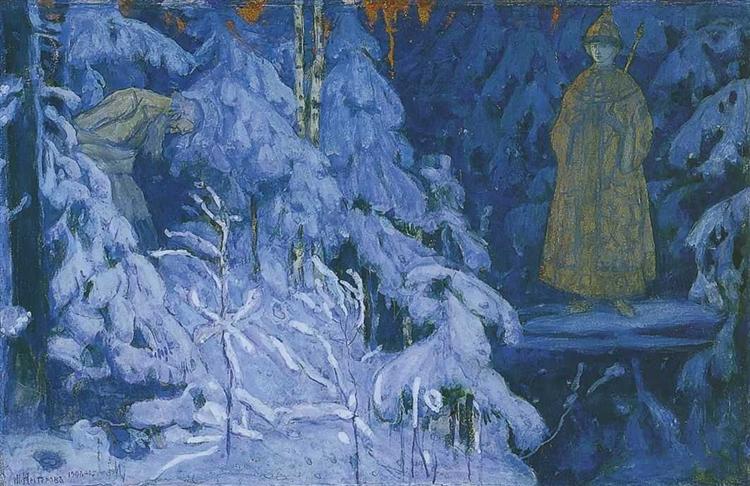Description
The work "The vision of the image of Ivan Susanin Michael - 1906" by Mikhail Nesterov is a precious manifestation of deep symbolism and the rooted sense of national identity that the Russian artist knew how to capture precisely in his creations. This painting, made in 1906, adds a significant chapter to the positioning of Nesterov as an eminent representative of the "Predvizhniki" or "itinerant", a group of Russian artists who sought to take art to the general public, challenging academic conventions.
The image presents Ivan Susanin, a hero of Russian folklore known for his sacrifice during the Time of Troubles, turbulent period in Russian history at the beginning of the 17th century. Susanin is famous for having taken a troop of Polish invaders along a false road, at the expense of his own life, to protect Mikhail Romanov, the first tsar of the Romanov dynasty. In the midst of a gloomy landscape, figures emerge that evoke both the supernatural and the historical. The interaction between the mystical and the real is nourished by a composition that reinforces the inspired and dramatic character of the moment.
The central approach of the painting is the mature figure of Ivan Susanin, represented with a serenity and firmness that seem to seal its heroic destiny. Mikhail Nesterov uses a sober color palette but with strong chromatic contrasts, emphasizing the timelessness and importance of the captured moment. The terrious tones and the use of clear-dark manage not only to define the main character, but also suggest the dreadful nature to which it faces. Detailed figuration and almost spiritual atmosphere induce the viewer to a deep reflection on sacrifice and martyrdom.
Likewise, the integration of the natural elements surrounding Susanin can be pointed out: the gloomy forest, the mountains and the sky, all seem to participate in the vision of the hero, endowing the nature of an almost narrative role. The presence of these elements alludes to the interconnection between man and its surroundings, a characteristic that Nesterov frequently used to add layers of meaning and to underline the mysticism inherent in their themes.
In terms of technique, Mikhail Nesterov uses precise and soft brushstrokes that allow a gradual transition between elements, adding to painting an almost ethereal texture. This technique is consistent with its general style, which always tried to amalgamate human figures with the landscapes, creating a fusion between the divine and the earthly.
It is impossible to talk about this work without mentioning the resonances it has with other works by Nesterov, such as "the great tonsure of San Sergio" (1898) and "Christ and Nicodemus" (1899-1900), where the combination of religious issues and Mystical landscapes becomes the unmistakable rubric of the artist. His works reflect a spiritual search and an imperturbable devotion towards Russian values and an epic narrative of its history.
"The vision of the image of Ivan Susanin Michael" is not only consolidated as a peak of Nestterov production, but also acts as a prism through which the depth of the Russian national spirit can be observed, represented through the courage and sacrifice. In this fusion of art, history and symbolism, Nestterov manages to accentuate his place in the Olympus of the great Russian artists, leaving a perennial legacy in the cultural landscape of his homeland.
KUADROS ©, a famous paint on your wall.
Hand-made oil painting reproductions, with the quality of professional artists and the distinctive seal of KUADROS ©.
Art reproduction service with satisfaction guarantee. If you are not completely satisfied with the replica of your painting, we refund your money 100%.

